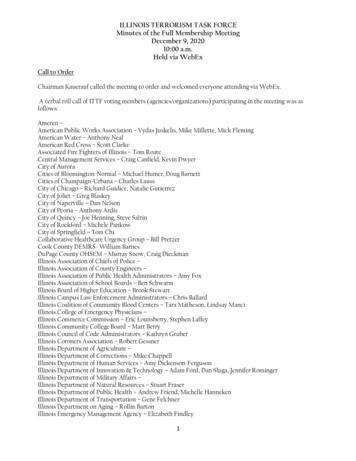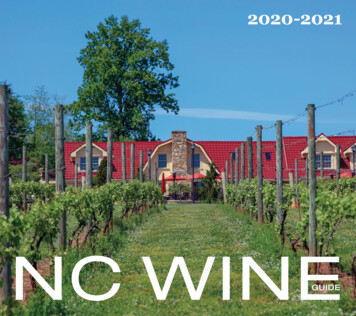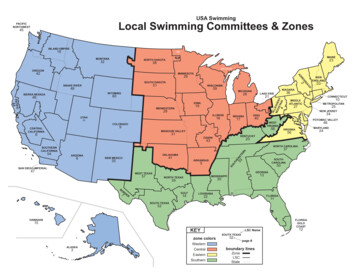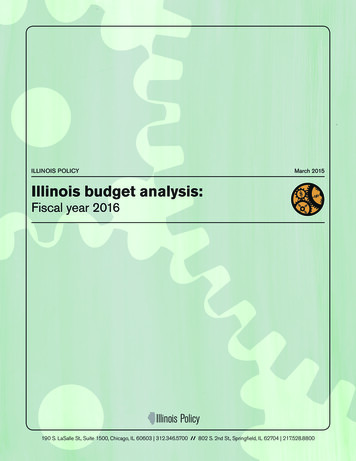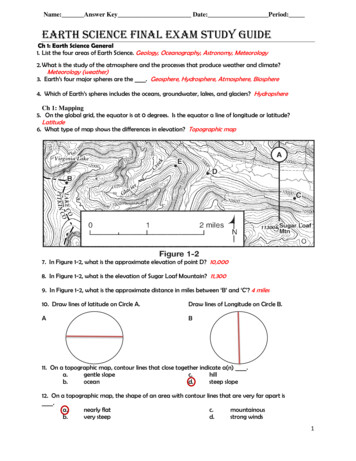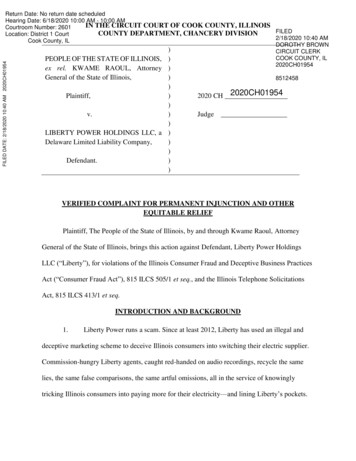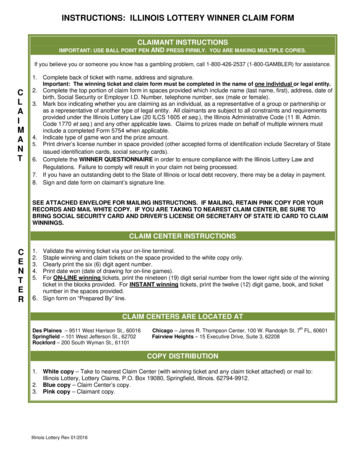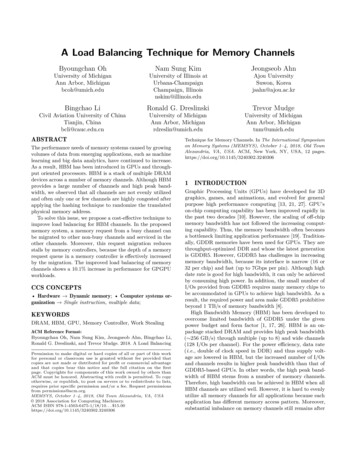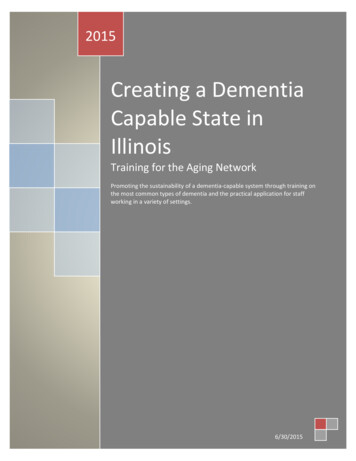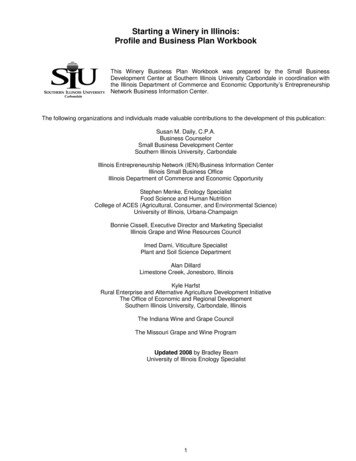
Transcription
Starting a Winery in Illinois:Profile and Business Plan WorkbookThis Winery Business Plan Workbook was prepared by the Small BusinessDevelopment Center at Southern Illinois University Carbondale in coordination withthe Illinois Department of Commerce and Economic Opportunity’s EntrepreneurshipNetwork Business Information Center.The following organizations and individuals made valuable contributions to the development of this publication:Susan M. Daily, C.P.A.Business CounselorSmall Business Development CenterSouthern Illinois University, CarbondaleIllinois Entrepreneurship Network (IEN)/Business Information CenterIllinois Small Business OfficeIllinois Department of Commerce and Economic OpportunityStephen Menke, Enology SpecialistFood Science and Human NutritionCollege of ACES (Agricultural, Consumer, and Environmental Science)University of Illinois, Urbana-ChampaignBonnie Cissell, Executive Director and Marketing SpecialistIllinois Grape and Wine Resources CouncilImed Dami, Viticulture SpecialistPlant and Soil Science DepartmentAlan DillardLimestone Creek, Jonesboro, IllinoisKyle HarfstRural Enterprise and Alternative Agriculture Development InitiativeThe Office of Economic and Regional DevelopmentSouthern Illinois University, Carbondale, IllinoisThe Indiana Wine and Grape CouncilThe Missouri Grape and Wine ProgramUpdated 2008 by Bradley BeamUniversity of Illinois Enology Specialist1
TABLE OF CONTENTSINTRODUCTION . .3THE BUSINESS PLAN – Title Page/Executive Summary . .4THE BUSINESS PLAN – General Business Information . .6The Illinois Grape and Wine Industry. .6The Midwest Wine Industry. .8The United States Wine Industry . .9Economic Impact of Wine and Winegrapes in Illinois 2005 .10Industry Information, Business Description and Products Offered . 13THE BUSINESS PLAN - Marketing . 15Target Market . 16Competition . 16Marketing Strategy – Product . 18Marketing Strategy – Price. 19Marketing Strategy – Place (Distribution Strategy) . 21Marketing Strategy – Promotion . 22THE BUSINESS PLAN - Management/Operations . 23Business Organization . 23Business Registration . 25Management and Employees . 26Labor Planning . 28Payroll Taxes . 31Insurance . 31Suppliers . 32Professional Consultants . 32Licenses & Permits - TTB . 33Licenses & Permits – Local/County Liquor Control Commission . 35Licenses & Permits – Illinois Liquor Control Commission . 35Licenses & Permits – Illinois Department of Public Health . 36Outside Influences . 38THE BUSINESS PLAN – Financial Section . 39Financial Projections and Supporting Information . 39The 5 “C’s” of Credit. 40Cost Estimate for Establishment of a Five Thousand Gallon Winery . 41Winery Facility Establishment Cost Worksheet . 43Equipment Planning . 44Equity Investment Worksheet . 46Sources and Uses of Funds Worksheet . 47Sales Projection Worksheet . 48Operating Expense Worksheet . 49Personal Financial Statement . 50GOVERNMENT AGENCY FINANCING PROGRAMS . 52ADDITIONAL RESOURCES . 55Consultants . 55References - Books . 58References – Organizations, Newsletters, and Websites . 59References – Magazines . 60References – Winery Supplies and Equipment . 60Quick Reference Guide to Wine Excise Tax. 63References – Glossary of Wine Terms . 662
INTRODUCTIONStarting a successful winery involves education in viticulture, the science of growing wine grapes, enology, the science of winemaking, and business planning.A list of several excellent resources for viticulture and enology information is included in the resource section,but this workbook is intended to focus on the business aspect of starting a winery. It will serve as a guide tohelp you write your Winery Business Plan. After completing the workbook, you should have a clearerunderstanding of your business concept and the requirements and commitment it will take to turn your conceptinto a reality. You will also be more prepared to discuss your project with others, such as bankers or investors.It is important to remember that a Business Plan can serve two primary purposes: (1) to be your “road map” insetting up and managing your winery business and (2) to support a loan request. To develop a good businessplan, you will need to do research in all aspects of your business. A good business plan has the followinggeneral sections: Title Page. The title page of your business plan should provide the readerwith general contact information including the name of the winery and thename, address, and phone number of the owner(s). Executive Summary. This introductory section provides the banker orinvestor a “first impression” of your business concept, typically in one pageor less. Although it appears near the front of the plan, it is most effectivelywritten after the rest of your plan is completed. General Business Information. This section describes the type ofbusiness, the product(s) and/or services(s) offered, location, and thegeneral business conditions affecting the Illinois wine industry. Marketing. This section identifies the winery’s mission statement, targetmarket, competition, pricing strategy, distribution strategy, and promotionplan. Management and Operations. The purpose of this section is to describethe legal form of the business, skills available within management tosuccessfully run the business, employee information, and otherconsiderations necessary to successfully operate and manage thebusiness. Financial Information. This section should include a thorough analysis ofthe use of financing proceeds, five-year financial projections, and owner’sequity information.This workbook will take you through the process of developing all areas of the business plan. It may benecessary to alter the contents of the workbook to suit the particular circumstances involved in your business.Some areas may not relate to your business concept at all, and some areas may require additional information.Becoming an entrepreneur involves a deep financial and emotional commitment. It’s important to rememberthat you are risking your money and perhaps your financial security. Lending institutions and/or investors arealso sharing the risk in your business venture, and your business plan is the necessary tool they will use toevaluate their willingness to assume that risk. Many small businesses fail, and often this is due to inadequateplanning. While others can help with the planning effort, only you really know what you want your business tobe.The Illinois Small Business Development Center Network is here to assist and counsel you through theplanning process. For assistance in determining the location of the center in your area, or accessing othersmall business information, contact the IEN Business Information Center at 1-800/252-2923, (TDD 1-800/7856055) or visit their website at www.ienconnect.com.3
THE BUSINESS PLAN – Title Page and Executive SummaryThe Title Page and Executive Summary provide the banker or investor a “first impression” of your businessconcept. Although they are the first parts of the plan to be read, it is most effective if they are the last parts youwrite. It just makes sense that you need to go through the entire business planning process before you caneffectively write an executive summary that covers all the critical elements.BUSINESS PLANGOOD GRAPES WINERYJohn & Elise Winemaker100 Wineglass RoadGood Grapes, IL 65432(555) 555-5555Title PageThe Title Page should be a professional presentation giving thereader general contact information. It should be neat, attractive,and short. The Title Page should: Identify the winery and the document. Identify the principals and the location and telephonenumbers where they can be reached.Some optional items that are often included on the Title Page are: A graphic that represents the business. This is typically apicture of the business or product or a copy of the business’trademark. A few sentences that state the company’s mission or a shortsummary of the financing request.The items included on the title page may seem obvious, but it’s amazing how many business plans aresubmitted for financing that don't have a title page or have an incomplete one. Nothing will turn off an investorfaster than having to look up your telephone number in the phone book because you left it off the title page.Executive SummaryThe Executive Summary is usually half a page to a page in length and is a basic summary of the key elementsof the business plan. Sometimes the Executive Summary is all the potential investor or lender will read, so itmust capture his/her attention. It should make an immediate impact on the reader and clearly state the natureof the business and, if you are seeking financing, the nature of the financing request. If the Executive Summaryfails to move the potential investor into the depths of the plan, it has failed to do its job. The Executive Summaryshould include: The name and address of the winery. The owner(s) names. Brief description of the winery. Types of wines and other product(s) and/or service(s) to be offered. Purchase terms, if buying an existing business. Requested loan amount and how the loan will be repaid. How the loan amount will be spent (broken down into broad categories). Amount and form of owner(s) equity (owner’s investment in the business). Expected outcome of business operations.4
Executive SummaryWrite an executive summary that summarizes the rest of the business plan and sells your business idea to thepotential investor.5
THE BUSINESS PLAN - General Business InformationThe purpose of this section is to expand on the executive summary and explain in detail who you are, whatyou are going to do, and how you plan to do it. For a winery, this section typically includes: A short description of the Illinois and/or United States wine industry. What kinds of trends are responsible for the industry’s growth. A detailed description of your winery. The location of your winery.Proper site selection is one of the most important factors in establishing a winery. Typically,wineries have a strong tourism element. Therefore, access to the location will be important. While itis not important to be along a major highway, tourists need a reason to visit. Types of wines to be produced.Will you be producing wine from Illinois grapes, imported juice, or other types of fruit?Will the wines eventually be produced from grapes harvested from your own vineyard? Other products and/or services to be offeredSmall wineries typically offer additional products or services that appeal to the wine customer, suchas a vineyard, gift shop, or art gallery. These additions make the winery more appealing to thetourist customer base and offer the winery additional sources of income. What differentiates your winery from the competition. A sense of where you want the business to be in three to five years, and how you plan to achieve thesegoals. History of the business if the business plan is to be used to support the purchase or expansion of anexisting winery.Details should include years in existence, current owner, current location, market share, strengths,weaknesses, and financial information for the past three to five years.The Illinois Grape and Wine IndustryIn the mid 1990’s, a number of grape growers, wine producers, legislators, and representatives from SouthernIllinois University – Carbondale and University of Illinois – Urbana/Champaign met to discuss the idea of a statesupported council. Several survey teams were formed to provide information relevant to the Illinois grape andwine industry. An industry profile was developed that showed significant growth potential for the wine industryin Illinois, both within the state and as an exported product. (1997 Illinois Winemakers Benchmarking Development Project)The following facts support this conclusion: According to US Wine Stats, in 1996 Illinoisans consumed 25 million gallons of wine, 705 million in sales. Illinois has retained a rank as the fifth largest wine consuming state in the country over several years. Chicago is the second largest metro market in the U.S. in wine consumption, second only to Los Angeles. Illinois ranked second in the consumption of champagne/sparkling wine in 2000, 1.50 million 9-liter cases.(Adams Wine Handbook 2001) In 2001, California was the top market for brandy, with about 20% of all sales reported there, followed byNew York, with 8% and Illinois with 6%. (Wines and Vines Magazine, 3/28/02)Although consumption of wine in this state is quite substantial, production of Illinois wines amounts to less thanone percent of total gallons consumed.6
To help Illinois producers capture more of that market, the Illinois Legislature established the Illinois Grape andWine Resources Council (Wine Council) in 1997. The legislation included funds to support research,educational programs, and promotional efforts. The state continues to support the Wine Council with annualallocations from the state’s tourism fund. With the establishment of the Wine Council, and through thepartnering efforts with the Illinois Grape Growers and Vintners Association, Illinois is experiencing a turnaroundin the grape and wine industry, not only in increased production, but heightened awareness, appreciation, and,sales. In its first year of existence, the efforts of the Wine Council contributed to a statewide jump in Illinoiswine sales from 2 million to 7.5 million.The Wine Council has focused on growing the industry by educating potential winemakers and vintners andestablishing acceptance of Illinois wines in the marketplace. The wine garden at the Illinois State Fair andstatewide marketing materials are examples of how the council is working to increase awareness of statewines. These efforts are paying off with a resurgence of the Illinois wine industry. In 1995, there were ninewineries in Illinois. By the end of 2001, there were 27 wineries in operation. Within the next ten years, tourismexperts predict that Illinois wineries will create more than 1,300 jobs and generate more than 60 million ineconomic activity.Jo Da vie ssSte p he nso n Winne b a g oBo o neMc He nryLa keC a rro llOg leDe Ka lbKa neDu Pa g e C oo kWhite sid eLe eKe nd a llBure a uWillHe nryRo c k Isla ndG rund yLa Sa lleMe rc e rPutna mSta rkKno xKa nka ke eMa rsha llWa rre nLiving sto nWo o d fo rdPe o riaHe nd e rso nIro q uo isTa ze we llMc Do no ug hn oili mr eVC ha m p a ig nMa so nLo g a nDe wittSc huyle rMe na rdPia ttC a ssAd a m sMa c o nBro wnMorg a nSc o ttG re e neDo ug la sSa ng a m o nEd g a rei rtl u o MPikeFo rdMc Le a nFulto nHa nc o c kC hristia nMa c o up inC o le sShe lb yMo ntg o m e ryCla rkC m b rlndn u o hl a CFa ye tteEf fing ha mJe rse yJa sp e rBo ndC ra wfo rdMa d iso nC la yC linto nJe f e rso ns dr a wd EWa yneWa shing to nM o nro eLa wre nc eRic hla ndMa rionSt. C la irRa nd o lp hMost Illinois wine is made from grapes. Some specialty wines,especially in southern Illinois, are made from locally grown fruits, suchas apples, blackberries, blueberries, cherries, peaches, andraspberries.Although the industry is still considered in its infancy,several Illinois wines have received national recognition for theirexcellence.Wa b a shWhitePe rryFra nklinJa c kso nWillm 'so nUnio nJo hnso nAle xa nd e r Pula skiHa m ilto nSa linePo p eGa lla tinHa rd inMa ssa cWith establishment of the Wine Council, grape growers are alsoexperiencing resurgence in their industry in Illinois. Prior to prohibition,Illinois was dominant in the grape growing industry, but statisticsshowed that only 82 acres of grapes were in existence in 1996. Pastestimates indicated that less than 20 percent of the wines made byIllinois wineries were made with Illinois-grown grapes. In 1998, only10,000 gallons of wine were produced in Illinois using Illinois grapes.This low percentage was not due to wineries’ distaste for Illinois grapes,but due to a lack of supply. As a follow-up survey to the 1997 IllinoisWinemakers Benchmarking report, all wineries questioned indicated apreference for Illinois grapes, assuming quality and taste standardswere in place. Illinois vintners have responded and as of 2001, theWine Council reported 175 vineyards operating in Illinois with 650 acresof grapes planted.History of Illinois Wine IndustryYearAcres 01819982408214199714019968219544001925 3,000Total ion for this table was generously provided by the Illinois Grape and Wine Resources Council.7
The Midwest Wine IndustryIn addition to Illinois, other Midwestern states are also experiencing a resurgence in their wine industries. Salesof Indiana wines have more than tripled since 1994 and Missouri wine sales have doubled in the same timeperiod. Legislative support from the three state governments has been the force behind this dramatic growth.The Indiana Wine and Grape Council and the Missouri Grape and Wine Program were developed with thesame goals as the Illinois Grape and Wine Resources Council for their respective states. This is similar to thestrategy used by the California wine industry in the 1980’s.“Before the 1980’s, people didn’t think of California wine as fine wine, they thought of it as jug wine,” explainsBonnie Cissell, executive director of the Illinois Grape and Wine Resources Council. “Then California pouredtons of money into marketing, and they were supported by their state legislators. So now, what is perceived tobe good wine is strongly influenced by what comes out of California.” Due to weather, soil, and other factors,Illinois and the other Midwest states cannot cultivate the same wine grapes as California. “We can’t growChardonnay. We can’t grow Merlot. We grow French hybrids, which can withstand the cold temperatures andthe high humidity,” explains Cissell. Rather than compare Illinois and California varieties, she suggests thatwine drinkers judge Illinois wine on its own merits.Nationwide industry publications such as Vineyard and Winery Management Magazine are recognizing theprogress in the heartland. The US wine industry as a whole is on the rise and the Midwest wine industry isbenefiting from that growth.A Comparison of the Illinois, Indiana, and Missouri Wine and Grape Industries1994 – 2001Illinois data provided by the Illinois Grape and Wine Resources Council.Indiana data provided by the Indiana Grape and Wine Council.Missouri data provided by the Missouri Wine and Grape Program.Number *165*1952501100**700***1000Total 04,000329,000380,000388,000415,000450,000*“This year we're expecting approximately 1.5 million people will visitour 30 wineries. While we realize our numbers don't approachthose of larger wine producing states such as California orWashington, there's clearly no shortage of enthusiasm among winelovers about what we're accomplishing with our special grapevarieties right here in America's heartland.”Excerpted from the Missouri Wine and Grape Program Website.“With a growth rate of over 25% for the past five years in gallonssold, the Indiana wineries and grape growers are prospering fromthe fruits of their labor.”Excerpted from the Indiana Grape and Wine Council Website.8
The United States Wine IndustryThe wine industry in the United States has experienced steady growth over the past 25 years. Between 1945and 1970, the consumption of wine in the United States was quite modest, but nevertheless fairly consistent interms of both volume and revenue growth. Beginning in the early 1970’s, however, demand began to increasedramatically. The total gallons of wine consumed more than doubled in between 1970 and 1980, and continuedto expand rapidly in the early 1980’s, due in part to the development and popularity of wine coolers. Adecrease in wine consumption was experienced in the early 1990’s, but the dollar amount of retail salescontinued its steady growth. Since 1995, the industry has again been experiencing significant growth in bothwine consumption and retail sales of wine.Wine Sales in the U.S.1975-2000YearVolume Entering Trade ChannelsRetail Sales of Wine2000565 million gallons 19.0 billion1999551 million gallons 18.1 billion1998526 million gallons 17.0 billion1997520 million gallons 16.1 billion1996500 million gallons 14.3 billion1995464 million gallons 12.2 billion1990509 million gallons 11.7 billion1985580 million gallons 10.8 billion1980480 million gallons 6.2 billion1975368 million gallons 3.3 billionSource: Gomberg, Fredrikson & Associates (volume) and Wine Institute (value).Wine Consumption in the U.S.1940-2000Total Wine perTotal WineTotal Table WineResidentGallonsGallons20002.01 gals.565 million505 million19992.02 gals.551 million482 million19981.95 gals.526 million466 million19971.94 gals.520 million461 million19961.89 gals.500 million439 million19951.77 gals.464 million404 million19902.05 gals.509 million423 million19802.11 gals.480 million360 million19701.31 gals.267 million133 million19600.91 gals.163 million53 million19500.93 gals.140 million36 million19400.68 gals.90 million27 millionSource: Wine Institute/ Gomberg, Fredrikson & Associates.9
ECONOMIC IMPACT OF WINE AND WINEGRAPES IN ILLINOIS2005From MKF Research, LLCEXECUTIVE SUMMARYAlthough winemaking in Illinois dates from at least 1885, ninety percent ofIllinois’ vineyards and 83 percent of Illinois’ wineries have been established inthe last ten years. In just the last three years, the number of wineries andvineyards have doubled, so that today there are 68 wineries and 450 vineyards inthe state.The wineries of Illinois produce 500,000 gallons of wine per year. MKF ResearchLLC estimates that Illinois wineries’ revenues from wine sales total 21 million,taking into account both direct sales and the wineries’ share of revenue for winesold through the three-tier system. There are approximately 450 grape farmers inthe state with 1,100 bearing acres.Wine and winegrapes and related industries created more than 253 million1 oftotal economic value to the state of Illinois for 2005. The wine and winegrapeand sectors paid at least 22.9 million in state and local taxes in the state in 2005.Wine and winegrapes and related industries account for nearly 2,300 jobs acrossthe state, for a payroll of more than 59.6 million.Investing in a vineyard is a long-term commitment to a specific place. Newlyplanted vineyards need four years to produce a harvest. Another year to threeyears is needed to turn those grapes into wine. The soil and climate in whichgrapes are grown define the taste and style of the wine the grapes will become.Wine must contain 75% Illinois grapes to be labeled Illinois wine. Thus, unlikemanufacturing or service enterprises, Illinois’ vineyards and wineries producingIllinois wine cannot easily be moved to another state which might offer a betterbusiness climate or tax incentives.CHALLENGES AND OPPORTUNITIESChallengesIllinois’ wine and winegrape producers face a complex array of challenges.Trained Labor and Availability of TrainingIllinois has a serious shortage of trained viticulture and enology professionals, ashortage that has constrained the continued expansion of the winegrape industryas well as its continuing efforts to improve grape quality.Lacking a state enologist and viticulturist, the industry has relied on part-timeassistance and agricultural assistance. Viticulture and enology degree programsare alsolimited. Moreover, most of the states with growing winemaking andgrape growing industries supplement their formal degree programs and extensionservices with extensive in-service, part-time courses for mid-career professionalsto continue to improve their skills, including wine business courses as well astechnical training. The offerings here too are somewhat limited, primarily one dayseminars sponsored by IGGVA and the University of Illinois at Champaign, theIllinois Department of Agriculture and others. Southern Illinois University isanother professional source of class and seminar offerings. Continuing to buildthis institutional infrastructure will help ensure the long-term strength of Illinois’swine and winegrape industry.Grape ShortageShortage of quality grapes also remains an issue for wineries. Demand for the bestgrapes has outstripped their supply as wine sales continue to grow. A wine needsto contain at least 75% Illinois grapes to be labeled as an Illinois wine. Cropdamage from two freezes in spring 2005 inhibited the growth of Illinois wineproduction in 2005.10
Consequently, many wineries, particularly the larger wineries, are importinggrapes. New sources of grapes and grape juice from California and Michigan andsome other states are helping ease the shortage and providing more variety towines produced in Illinois. In some cases, grapes brought in from California areless expensive than those grown locally. Some Illinois winemakers use suchgrapes to make classic vinifera style wines or blend them with native or hybridvarietal grapes to create new blends, although they may not be able to label themas Illinois appellation wines.Scarcity of FinancingTh
Profile and Business Plan Workbook This Winery Business Plan Workbook was prepared by the Small Business Development Center at Southern Illinois University Carbondale in coordination with the Illinois Department of Commerce and Economic Opportunity’s Entrepreneurs
